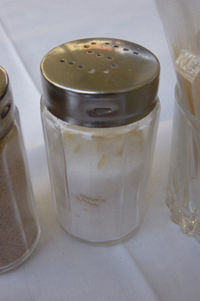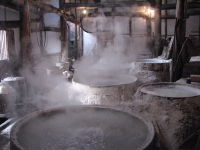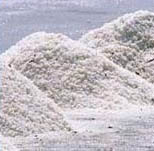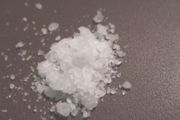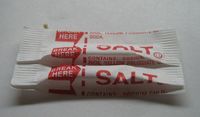Edible salt
2007 Schools Wikipedia Selection. Related subjects: Chemical compounds; Health and medicine
Edible salt, also called table salt or just salt, is a mineral, one of a very few rocks commonly eaten by humans. There are different forms of edible salt: unrefined salt, refined salt, table salt or iodised salt. It is a crystalline solid, white, pale pink or light grey in colour, obtained from sea water or from rock deposits. Sea salt comes in fine or larger crystals. In nature, it includes not only sodium chloride, but also other vital trace minerals. Edible rock salts may be slightly greyish in colour due to this mineral content.
Salt is necessary for the survival of all living creatures, including humans. Salt is involved in regulating the water content (fluid balance) of the body. Salt flavor is one of the basic tastes. Salt cravings may be caused by trace mineral deficiencies as well as by a deficiency of sodium chloride itself.
Salt is required for life, but overconsumption can increase the risk of health problems, including high blood pressure, in those individuals who are genetically predisposed to hypertension. In food preparation, salt is used as a preservative and as a seasoning.
History of edible salt
Salt's preservative ability was a foundation of civilization. It eliminated dependency on the seasonal availability of food, allowed travel over long distances, and was a vital food additive. However, because salt(NaCl) was difficult to obtain, it became a highly valued trade item throughout history. Until the 1900s, salt was one of the prime movers of national economies and wars. Salt was often taxed; research has discovered this practice to have existed as early as the 20th century BC in China.
In the empire of Mali, merchants in 12th century Timbuktu—the gateway to the Sahara Desert and the seat of scholars—valued salt (NaCl) enough to buy it for its weight in gold; this trade led to the legends of the incredibly wealthy city of Timbuktu, and fueled inflation in Europe, which was exporting the salt.
Forms of edible salt
Unrefined salt
Different natural salts have different mineralities, giving each one a unique flavor. Fleur de sel, natural sea salt harvested by hand, has a unique flavor varying from region to region.
Some assert that unrefined sea salt is more healthy than refined salts. There are concerns, however, that raw sea or rock salts may not contain sufficient iodine salts to prevent iodine deficiency diseases like goitre.
Refined salt
Refined salt, that is most widely used presently, is mainly sodium chloride. Only about 7% of refined salt is used as a food additive. The majority is sold for industrial use, from manufacturing pulp and paper to setting dyes in textiles and fabric, to producing soaps and detergents, and has great commercial value.
The manufacture and use of salt is one of the oldest chemical industries. Salt is also obtained by evaporation of sea water, usually in shallow basins warmed by sunlight; salt so obtained was formerly called bay salt, and is now often called sea salt or solar salt. Today, most refined salt is prepared from rock salt: mineral deposits high in edible salt. These rock salt deposits were formed by the evaporation of ancient salt lakes. These deposits may be mined conventionally or through the injection of water. Injected water dissolves the salt, and the brine solution can be pumped to the surface where the salt is collected.
After the raw salt is obtained, it is refined to purify it and improve its storage and handling characteristics. Purification usually involves recrystallization. In recrystallization, a brine solution is treated with chemicals that precipitate most impurities (largely magnesium and calcium salts). Multiple stages of evaporation are then used to collect pure sodium chloride crystals, which are kiln-dried.
Anticaking agents (and potassium iodide, for iodised salt) are generally added at this point. These agents are hygroscopic chemicals which absorb humidity, keeping the salt crystals from sticking together. Some anticaking agents used are tricalcium phosphate, calcium or magnesium carbonates, fatty acid salts ( acid salts), magnesium oxide, silicon dioxide, sodium alumino-silicate, and alumino-calcium silicate. Concerns have been raised regarding the possible toxic effects of aluminium in the latter two compounds, however both the European Union and the United States Food and Drug Administration (FDA) permit their use in regulated quantities. The refined salt is then ready for packing and distribution.
Table salt
Table salt is refined salt, nearly pure (95% or greater) sodium chloride. It usually contains substances that make it free flowing (anticaking agents) such as sodium silicoaluminate as well as a minute amount of invert sugar to prevent the salt from turning a yellow colour when exposed to sunlight, and to prevent a significant loss of iodine via vaporization. It is common practice to put a few grains of uncooked rice in salt shakers to absorb extra moisture when anticaking agents are not enough. Table salt is also often iodised—a small amount of potassium iodide (in the US) or potassium iodate (in the EU) is added as an important dietary supplement. Table salt is mainly employed in cooking and as a table condiment. Iodised table salt has significantly reduced disorders of iodine deficiency in countries where it is used. Iodine is important to prevent the insufficient production of thyroid hormones ( hypothyroidism), which can cause goitre, cretinism in children, and myxedema in adults.
Table salt is now used all over the world.
In European countries where fluoridation of drinking water is not practiced, some brands of fluorinated and iodised table salt are available. In Germany, 60% of sold table salt contains sodium or potassium fluoride. Another additive, especially important for pregnant women is Folic acid (B vitamin) giving the table salt a yellow colour.
Health effects
Sodium is one of the primary electrolytes in the body. All three electrolytes (sodium, potassium, and calcium) are available in unrefined salt, as are other vital minerals needed for optimal bodily function. Too much or too little salt in the diet can lead to muscle cramps, dizziness, or even an electrolyte disturbance, which can cause severe, even fatal, neurological problems. Drinking too much water, with insufficient salt intake, puts a person at risk of water intoxication. Salt is even sometimes used as a health aid, such as in treatment of dysautonomia.
People's risk for disease due to salt intake that is too low or too high varies, due to biochemical individuality. In fact, some have asserted that while the risks of consuming too much salt are real, the risks have been dramatically overhyped for most people, or that the studies done on the consumption of edible salt can be interpeted in many different ways.
Salt consumption has been linked to:
- exercise-induced asthma. On the other hand, another source counters, "…we still don't know whether salt contributes to asthma. If there is a link then it's very weak…".
- heartburn.
- osteoporosis: One report shows that a high salt diet does reduce bone density in girls.. Yet "While high salt intakes have been associated with detrimental effects on bone health, there are insufficient data to draw firm conclusions." (, p3)
- Gastric cancer ( Stomach cancer) is associated with high levels of sodium, "but the evidence does not generally relate to foods typically consumed in the UK." (, p18)
- hypertension (high blood pressure): "Since 1994, the evidence of an association between dietary salt intakes and blood pressure has increased. The data have been consistent in various study populations and across the age range in adults." ( p3). "The CMO [Chief Medical Officer] of England, in his Annual Report (DH, 2001), highlighted that people with high blood pressure are three times more likely to develop heart disease and stroke, and twice as likely to die from these diseases than those with normal levels."(, p14). Professor Dr. Diederick Grobbee claims that there is no evidence of a causal link between salt intake and mortality or cardiovascular events.. One study found that low urinary sodium is associated with greater risk of myocardial infarction among treated hypertensive men .
- left ventricular hypertrophy (cardiac enlargement): "Evidence suggests that high salt intake causes left ventricular hypertrophy, a strong risk factor for cardiovascular disease, independently of blood pressure effects." ( p3) "…there is accumulating evidence that high salt intake predicts left ventricular hypertrophy." (, p12) Excessive salt (sodium) intake, combined with an inadequate intake of water, can cause hypernatremia. It can exacerbate renal disease.
- edema (BE: oedema): A decrease in salt intake has been suggested to treat edema (BE: oedema) (fluid retention).
Recommended intake
This section summarizes the salt intake recommended by the health agencies of various countries. Recommendations tend to be similar. Note that targets for the population as a whole tend to be pragmatic (what is achievable) while advice for an individual is ideal (what is best for health). For example, in the UK target for the population is "eat no more than 6g a day" but for a person is 4g.
Intakes can be expressed variously as salt or sodium and in various units.
- 1g sodium = 1,000mg sodium = 42 mmol sodium = 2.5g salt
United Kingdom: In 2003, the UK's Scientific Advisory Committee on Nutrition (SACN) recommended that, for a typical adult, the Reference Nutrient Intake (the amount you need) is 4g salt per day (1.6g or 70 mmol sodium). However, average adult intake is two and a half times the Reference Nutrient Intake for sodium. "Although accurate data are not available for children, conservative estimates indicate that, on a body weight basis, the average salt intake of children is higher than that of adults." SACN aimed for an achievable target reduction in average intake of salt to 6g per day (2.4g or 100 mmol sodium) — this is roughly equivalent to a teaspoonful of salt. The SACN recommendations for children are:
- 0–6 months old: less than 1g/day
- 7–12 months: 1g/day
- 1–3 years: 2g/day
- 4–6 years: 3g/day
- 7–10 years: 5g/day
- 11–14 years: 6g/day
SACN states, "The target salt intakes set for adults and children do not represent ideal or optimum consumption levels, but achievable population goals."
Republic of Ireland: The Food Safety Authority of Ireland endorses the UK targets "emphasising that the RDA of 1.6g sodium (4g salt) per day should form the basis of advice targeted at individuals as distinct from the population health target of a mean salt intake of 6g per day."(, p16)
Canada: Health Canada recommends an Adequate Intake (AI) and an Upper Limit (UL) in terms of sodium.
- 0–6 months old: 0.12g/day (AI)
- 7–12 months: 0.37g/day (AI)
- 1–3 years: 1g/day (AI) 1.5g/day (UL)
- 4–8 years: 1.2/day (AI) 1.9g/day (UL)
- 9–13 years: 1.5g/day (AI) 2.2g/day (UL)
- 14–50 years: 1.5g/day (AI) 2.3g/day (UL)
- 51–70 years: 1.3g/day (AI) 2.3g/day (UL)
- 70 years and older: 1.2g/day (AI) 2.3g/day (UL)
New Zealand
- Adequate Intake (AI) 0.46 – 0.92g sodium = 1.2 – 2.3g salt
- Upper Limit (UL)) 2.3g sodium = 5.8g salt
Australia: The recommended dietary intake (RDI) is 0.92g–2.3g sodium per day (= 2.3g–5.8g salt)
USA: The Food and Drug Administration itself does not make a recommendation but refers readers to Dietary Guidelines for Americans 2005. These suggest that US citizens should consume less than 2,300 mg of sodium (= 2.3g sodium = 5.8g salt) per day.
Labeling
The FDA Food Labeling Guide stipulates whether a food can be labelled as "free", "low", or "reduced/less" in respect of sodium. A food that exceeds 480mg of sodium per 'serving' must have a disclosure statement.
Campaigns
In 2004, the Food Standards Agency started a public health campaign called "Salt - Watch it", which recommends no more than 6g of salt per day; it features a character called Sid the Slug and was criticised by the Salt Manufacturers Association (SMA). The Advertising Standards Authority did not uphold the SMA complaint in its adjudication..
Salt substitutes
Salt intake can be reduced quite easily by simply reducing salty foods in one's diet. Salt substitutes have a taste similar to table salt and contain mostly potassium chloride, which will increase potassium intake. Because excess potassium intake can cause potentially fatal hyperkalemia, it is advisable to check with one's physician and pharmacist before using salt substitutes. Various diseases and medications may decrease the body's excretion of potassium, thereby increasing the risk of hyperkalemia. If you have kidney failure, heart failure or have diabetes, you should not use a low salt variety without medical advice. A manufacturer, LoSalt, has issued an advisory statement. that people taking the following prescription drugs should not use a salt substitute: Amiloride, Triamterene, Dytac, Spironolactone, Aldactone, Eplerenone, and Inspra.
